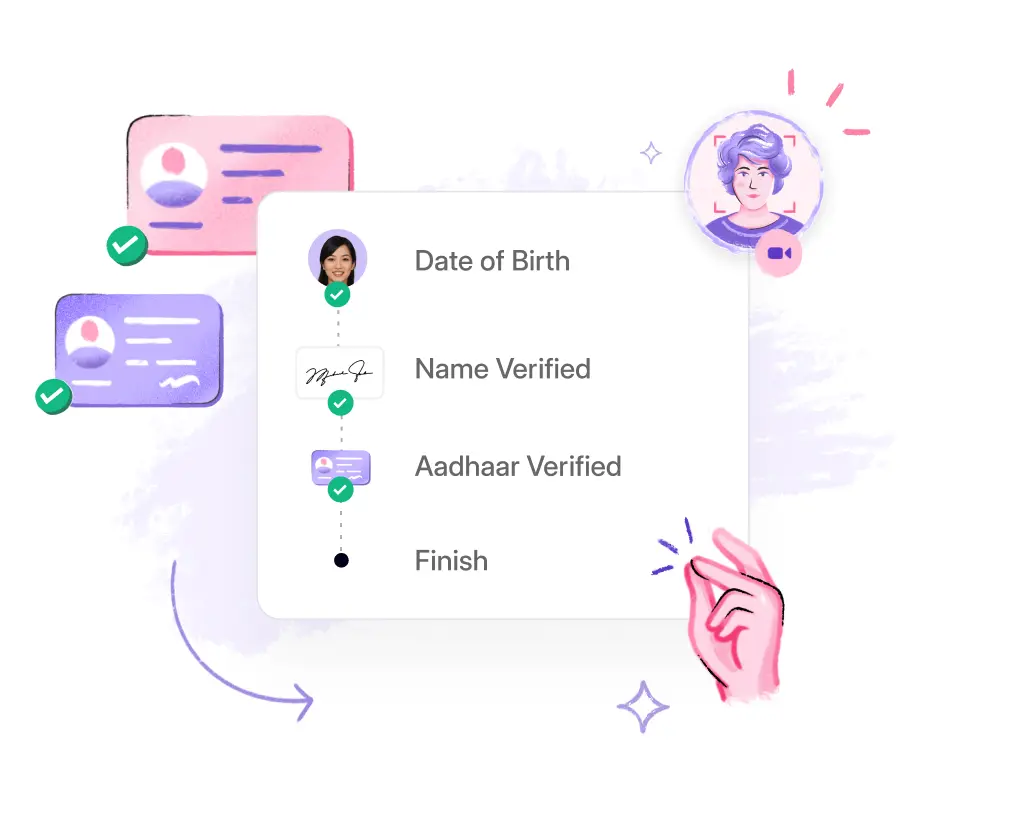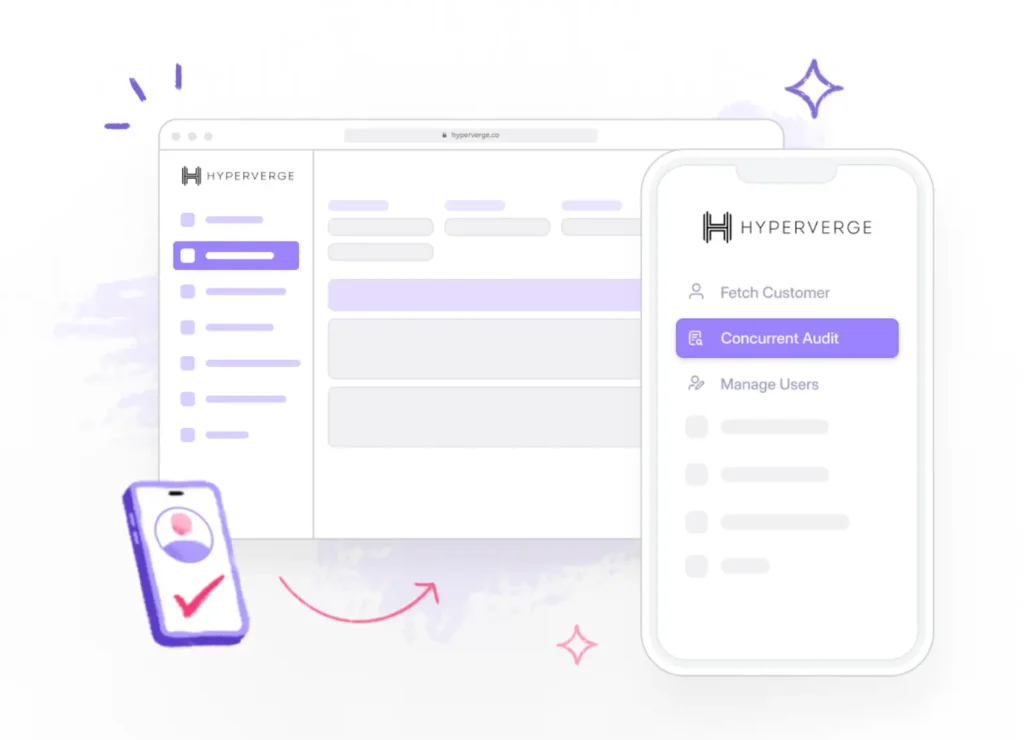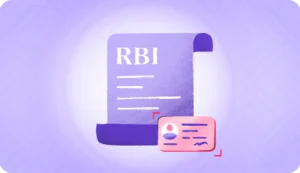As the financial technology landscape continues to evolve, the Reserve Bank of India (RBI) has emphasized the importance of compliance with customer verification guidelines for fintech startups.
During a series of meetings with industry representatives over the past few months, RBI officials have made it clear that adherence to these guidelines is crucial for onboarding new clients in 2024. This move aims to ensure the security and integrity of financial transactions while fostering trust between financial and their customers.
In this blog, we’ll explore the implications of these guidelines for fintech startups and how they can successfully navigate these regulatory requirements.
Understanding Video KYC process
Video KYC or Video-based Know Your Customer, uses live video interactions between customers and verification agents to confirm identities. This method not only meets regulatory requirements but also slashes the time and effort needed for verification.
By letting customers complete KYC procedures remotely, Video KYC eliminates the need for in-person visits, making it a convenient and efficient solution for both businesses and consumers.
The Video KYC process
The Video KYC process usually involves the following steps:
Initiation: The customer starts the KYC process via a digital platform, such as a mobile app or website, by providing basic information and scheduling a video call with a verification agent.
Document submission: Customers upload the necessary identification documents, like a passport, driver’s license, or Aadhaar card, through the platform. These documents are pre-verified using advanced Optical Character Recognition (OCR) technology to ensure accuracy and authenticity.
Live video interaction: During the scheduled video call, a verification agent interacts with the customer in real-time. The agent asks the customer to display their original identification documents and may request additional information or perform dynamic checks, such as asking the customer to blink or smile, to prevent fraud.
Face matching and liveness detection: Advanced facial recognition technology matches the customer’s face with the photo on their identification document. Liveness detection algorithms ensure that the customer is physically present and not using a static image or video recording.
Verification and approval: Once the video interaction and document verification are successfully completed, the verification agent approves the customer’s KYC. The entire session is recorded and securely stored for audit and compliance purposes.
Importance of Video KYC
- Speed and efficiency
Video KYC is significantly faster than traditional methods, as it takes minutes rather than days or weeks. This rapid process not only boosts customer satisfaction but also enables businesses to onboard clients quickly, providing a competitive advantage.
- Enhanced security and fraud prevention
Video KYC provides robust security with multiple layers of verification, including:
- Live video interaction: Ensures the customer is present with a real-time video call.
- Document verification: Customers display original identification documents, verified using advanced OCR technology.
- Facial recognition and liveness detection: Matches the customer’s face with their ID photo and confirms physical presence to prevent fraud.
- Compliance with regulatory requirements
Video KYC ensures compliance with strict KYC and AML regulations by offering a secure, auditable verification process. The recorded video interaction and stored data provide a complete audit trail for regulatory review.
- Convenience for customers
Video KYC offers customers the flexibility to complete verification from home or the office, eliminating the need for physical branch visits. This convenience boosts customer satisfaction and enhances the overall experience.
- Cost-effectiveness
Video KYC reduces the need for physical branches and manual processes, saving on operational costs. Its automation and efficiency also lead to faster onboarding and increased customer acquisition, boosting revenue.
- Scalability
Video KYC is scalable for businesses of all sizes, easily accommodating varying customer volumes. This flexibility benefits growing companies and those operating across multiple regions.
- Reduction in drop-off rates
By simplifying and speeding up the verification process, Video KYC reduces customer drop-off rates, improving conversion rates and enhancing user experience.
RBI guidelines and video KYC norms
Video KYC, or Video-based Customer Identification Process (V-CIP), the Reserve Bank of India has introduced this method for remote customer verification. It involves a live interaction between a customer and a bank representative through a secure video link, ensuring compliance with KYC regulations while enhancing convenience and security.
RBI Guidelines for V-CIP Infrastructure
The RBI requires banks and financial institutions to meet certain infrastructure standards when implementing V-CIP:
- Customer consent: Banks must obtain explicit consent from customers before starting the V-CIP process.
- Geo-tagging: The customer’s live photo is geo-tagged to confirm they are within India.
- Proprietary application: The video KYC application must is developed in-house by the regulated entities and deployed at specific customer touchpoints. Third-party video platforms are not permitted.
- Controlled domain: The video process should only be initiated from the lender’s domain and securely stored by the entity.
- Secure access: The application should be accessible only through secure methods like live OTP, time OTP, or login credentials.
- Document verification: Customers can present their documents either via video capture or by uploading them.
Guidelines for the V-CIP process
The V-CIP process is governed by the following guidelines:
- Aadhaar authentication: Only banks can use OTP-based Aadhaar e-KYC authentication or offline Aadhaar verification.
- Non-banking entities: Non-banking entities are restricted to using offline Aadhaar verification.
- Alternative documents: If customers opt out of using Aadhaar, they must provide other officially valid documents for verification.
- DigiLocker integration: Documents uploaded to the DigiLocker government platform are also acceptable.

V-CIP records and data management
Banks must ensure the secure storage of V-CIP records. The recorded video interactions, along with the verified documents, should be stored in a tamper-proof manner, ensuring they are accessible for regulatory audits. Additionally, the data management system should comply with relevant data protection regulations to safeguard customer information.

Cybersecurity measures for Video KYC
The RBI emphasizes stringent cybersecurity measures for V-CIP:
- Encryption: All data transmitted during the V-CIP process must be encrypted to prevent unauthorized access.
- Secure access: Only authorized personnel should have access to the V-CIP recordings and data.
- Regular audits: Banks should conduct regular security audits and vulnerability assessments to ensure the integrity of the V-CIP infrastructure.
Who does this apply to?
The implementation of video KYC is crucial for various industries, especially those dealing with sensitive financial transactions and personal data. Key industries and their use cases include:
- Banking and financial services: Video KYC is used for onboarding new customers, verifying loan applicants, and ensuring compliance with Anti-Money Laundering (AML) regulations. This process helps banks quickly and securely onboard new clients, reducing the risk of fraud and improving customer satisfaction.
- Insurance: Insurance companies use video KYC to streamline the policy issuance process and verify the identity of policyholders. This ensures that policies are issued to legitimate customers and reduces the risk of fraudulent claims.
- Telecommunications: Telecom companies use video KYC for verifying new SIM card applicants and preventing fraud. This helps ensure that SIM cards are issued to legitimate customers, reducing the risk of misuse.
- Fintech companies: Fintech companies leverage video KYC for quick and secure customer onboarding, meeting regulatory requirements while offering a seamless customer experience.
- E-commerce: E-commerce platforms use video KYC to verify sellers and buyers, ensuring a safe and trustworthy marketplace.
- Healthcare: In the healthcare industry, video KYC is used for verifying patient identities in telemedicine services and digital health platforms. This ensures that medical services are provided to the correct individuals, maintaining the integrity of patient records and healthcare services.
By adopting video KYC, these industries can enhance their customer verification processes, reduce fraud, and improve overall efficiency and customer satisfaction. This technology not only meets regulatory requirements but also provides a competitive edge by offering a secure, convenient, and efficient method of identity verification.
Transform your customer onboarding with HyperVerge’s industry-leading Video KYC solutions.
Ensure compliance with RBI’s 2024 guidelines while boosting efficiency and security. Schedule a DemoWhy choose HyperVerge for Video KYC?
Businesses today must prioritize efficient and secure customer verification processes. The RBI’s Video KYC guidelines offer companies a transformative opportunity to enhance their identity verification systems while ensuring compliance. HyperVerge stands out as a leading partner for implementing Video KYC solutions, providing a comprehensive suite of services that meet and exceed regulatory requirements.
HyperVerge’s advanced technology delivers unparalleled speed, accuracy, and security in customer verification. Our video verification ensures 100% compliance with RBI guidelines, simplifying authentication through seamless Video KYC verification. Our solutions integrate smoothly with Digilocker and KYC Record Upload management, incorporating sophisticated analytics to streamline KYC procedures, reduce fraud, and enhance customer satisfaction. With the ability to handle high volumes and work with low-quality images, HyperVerge’s solutions are scalable and adaptable across various industries.
Key HyperVerge solutions include:
- Agent-led VKYC: A dynamic and frictionless verification process with live agent support.
- Traffic Management: Options to wait for an agent or schedule a call, with a waiting room and scheduler for convenience, and geotagging to verify locations.
- Video Call: Randomized checks using verification codes for enhanced compliance, including PAN and selfie capture for face matching and liveness verification, along with customizable steps for capturing signatures or other documents.
- VCIP Portal: A central platform for logging and auditing, allowing for the configuration of shifts, slots, and holidays.
These solutions are designed to enhance compliance, streamline processes, and ensure high accuracy in customer verification. We support multiple workflows that can be seamlessly customized, allowing you to amplify customer interactions for Video KYC across any channel like WhatsApp, Gmail, or Slack.
Our platform drives agent success with AI-powered information extraction and offers a real-time analytics dashboard. Leverage our traffic management systems and scheduler for efficient performance, and utilize our automatic progressive dialer to reduce cognitive load for agents, making decision-making easier.
Choosing HyperVerge not only ensures compliance with regulations but also provides a competitive edge, fostering innovation and growth across the financial sector and beyond. Our expertise transforms your customer onboarding experience, making it more efficient, secure, and customer-friendly.
Ready to enhance your customer verification process? Take the first step towards a more secure and efficient customer onboarding experience. Contact HyperVerge today to learn how our video KYC solutions can help your business stay compliant and ahead of the competition.





